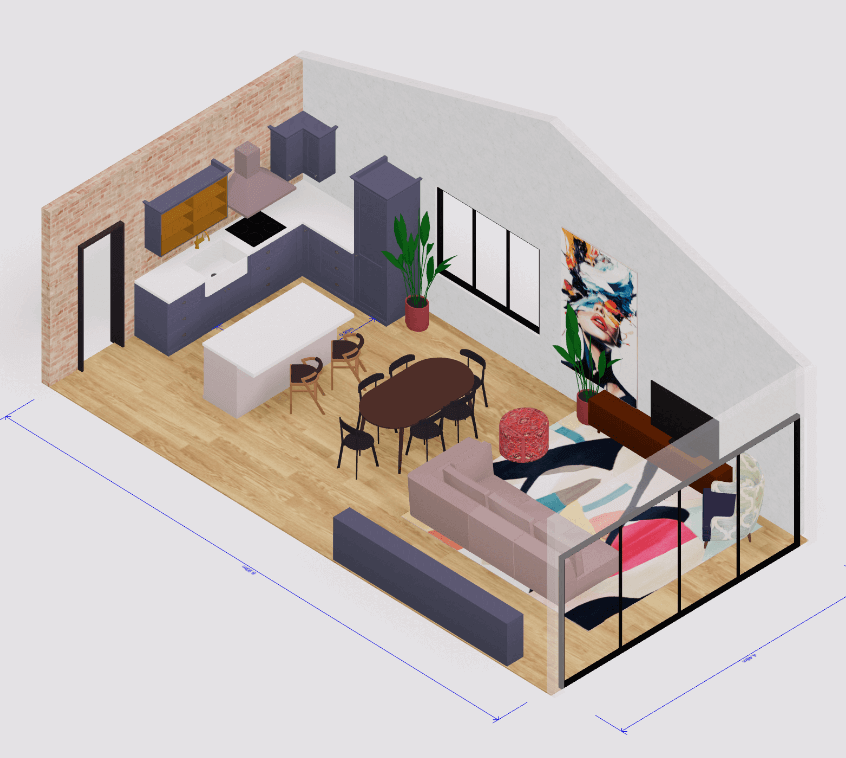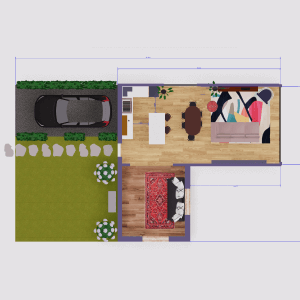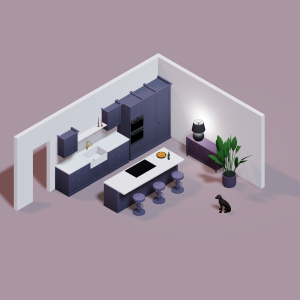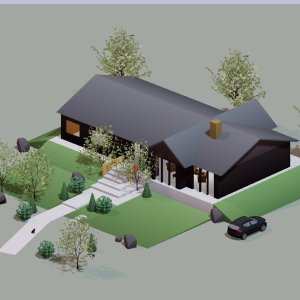Users often overlook software limitations, leading to designs that cannot be executed in reality. Certain 3D home modeling software sets constraints on structural elements, including wall thickness and height, which, if ignored, result in impractical plans. For instance, software might limit wall heights to a maximum of 10 feet, yet users may design without this consideration, creating plans that are unbuildable. Manufacturers report that over 30% of submitted home designs exceed realistic structural parameters, necessitating redesigns.
Clients frequently neglect to account for natural lighting, resulting in designs with poor illumination. Many programs offer tools to simulate sunlight at different times of the day, yet users often place windows without strategic consideration, leading to dark living spaces. Studies show that homes with inadequate natural light can increase energy costs by up to 25%, as artificial lighting becomes a necessity throughout the day.
Arcadium 3D ensures users are aware of software limitations upfront, minimizing the risk of unexecutable designs. Unlike general 3D modeling software where users might unknowingly exceed practical limits, Arcadium 3D guides users within realistic design parameters. Moreover, Arcadium 3D emphasizes the importance of natural lighting in its design interface, encouraging users to place windows strategically for optimal illumination, in contrast to other programs where this aspect might be an afterthought. As a browser-based 3D modeling software, Arcadium 3D simplifies the process, allowing interior designers and DIY enthusiasts to create practical, well-lit 3D house plans quickly and with ease, marking a significant advantage over competitors that may overlook these critical design considerations.
Contents:
Selecting Incompatible Software
Does your project have specific requirements? Identifying these needs ensures the selection of software that aligns perfectly with your goals. For instance, complex designs demand tools with advanced features like high-resolution rendering and detailed customization options. In contrast, simpler projects might only need basic functionality. Consequently, selecting software without assessing its capabilities against your project's demands can lead to significant inefficiencies.
Is the software compatible with other tools you use? Integration capabilities are crucial for a seamless workflow. Certain software offers robust compatibility with a wide range of applications, facilitating easy data transfer and collaboration. Others, however, might operate in isolation, making it challenging to synchronize work across different platforms. This disparity can stall progress and increase workload due to manual data entry and duplication of efforts.
Have you considered the learning curve? Every 3D modeling software has its unique set of features and interface, some being more user-friendly than others. High-end programs, while powerful, often come with a steep learning curve, requiring extensive training and practice. On the other end, more intuitive tools might lack advanced functionalities but can be quickly mastered, accelerating the design process. Therefore, overlooking the balance between complexity and usability can lead to prolonged project timelines and increased training costs.
In terms of project outcomes, software that meshes well with your project's scale and complexity tends to streamline the design process, unlike incompatible selections which can hamper progress. Tools fitting the project's scope enhance efficiency, allowing for a more fluid design experience and quicker adjustments. On the contrary, a mismatch between software capabilities and project requirements invariably leads to bottlenecks, necessitating workarounds that compromise the quality and precision of the final output.
Neglecting Software Tutorials and Guides
Why do some users overlook the available tutorials and guides? A common assumption is that these resources are unnecessary. Users frequently believe their experience in other software tools automatically equips them with the knowledge needed for new 3D home modeling applications. This oversight can lead to basic errors in design choices, mismanagement of the tool's features, and inefficient use of time.
How does this neglect impact the learning curve? Significantly, by bypassing tutorials and guides, individuals often find themselves facing a steeper learning curve. Without the foundational knowledge these resources provide, users must resort to trial and error–a method far more time-consuming and less effective than learning through structured guidance. The result is not just slower progress, but also a higher likelihood of frustration and mistakes.
Are there consequences for project outcomes? Absolutely. Neglecting educational materials can directly affect the quality of a project. For instance, users might apply incorrect textures or fail to optimize the spatial layout due to a lack of understanding of the software’s capabilities. Such errors not only compromise the aesthetic appeal but also the functional aspects of a design, leading to potential revisions that require additional time and effort.
Neglecting software tutorials and guides renders the learning process longer and more difficult, whereas utilizing these resources makes mastering the software more accessible and the design process smoother. Individuals who engage with these educational tools often produce higher quality designs with fewer errors, showing a direct correlation between initial investment in learning and the final project outcome. In essence, the effort to learn properly from the start establishes a foundation that enhances overall efficiency and effectiveness in using 3D home modeling software.
Ignoring Scale Precision in 3D Modeling
Why is ignoring scale precision in 3D modeling a significant error? It leads to inaccurate representations of spaces and objects. Designs appear unrealistic, and rooms might seem larger or smaller than their actual sizes. Furniture and fixtures might not fit as planned, causing delays and increased costs in real-world applications.
How do errors in scale precision manifest in final projects? These mistakes often result in doors that clash with furniture, windows that are too high or too low, and rooms that cannot comfortably accommodate their intended functions. Builders face challenges during construction, needing to adjust plans on the fly, which can lead to compromised structural integrity and aesthetics.
Does scale precision impact the visualization process? Absolutely, it undermines the ability to accurately imagine living or working spaces. Potential buyers or tenants might struggle to connect with the space, reducing its market appeal. Architects and designers find it difficult to convey their visions, leading to miscommunication and dissatisfaction with the final outcome.
In projects where scale precision is meticulously applied, the outcome is starkly more beneficial. Structures and interiors integrate seamlessly, enhancing functionality and comfort. Visualization becomes a reliable tool for decision-making, ensuring that expectations are met with fewer revisions required. This precision fosters a smoother transition from concept to construction, ultimately saving time and resources.
Overlooking Lighting and Textures
Do users often underestimate the importance of lighting in designs? Absolutely. Lighting profoundly influences the atmosphere of a space, setting the mood and highlighting key features. Different types of illumination, such as ambient, task, and accent, serve unique purposes. Ambient lighting provides overall illumination, task lighting focuses on areas for specific activities, and accent lighting draws attention to architectural features or artworks.
Is neglecting textures a common oversight? Indeed, textures add depth and realism to a design, making spaces feel more inviting or functional. Materials like wood, stone, and fabric each convey a distinct sense of warmth, durability, and comfort. Ignoring these can result in a flat and unappealing visual experience that fails to accurately represent the intended aesthetic.
Why do these elements matter? They bring designs to life, transforming them from mere sketches into vivid, immersive experiences. Properly executed lighting and textures can enhance spatial understanding, allowing viewers to grasp the volume, function, and beauty of spaces. They also aid in making informed decisions about material choices and lighting solutions before any physical work begins.
In essence, attention to lighting and textures significantly elevates a design's quality, far beyond that of projects where these aspects are ignored. Designs with well-considered lighting appear more vibrant and dynamic, while those with carefully chosen textures feel richer and more tangible. This thoughtful integration of lighting and textures not only enhances visual appeal but also ensures a more accurate and effective communication of design intentions.
Lack of Regular Data Backup
Do users often underestimate the importance of consistent data backups? Absolutely. Many assume their projects will remain safe without regular saves, leading to potential data losses. Failures in hardware, software glitches, and accidental deletions act as common culprits behind such losses. Regular backups serve as a safety net, ensuring that hours of meticulous work do not vanish into oblivion.
Is setting a reminder for backups a tedious task? Not in the slightest. Automating backups can simplify the process, making it less likely to be overlooked. Tools and features within many 3D home modeling software packages offer automatic scheduling options. Users find peace of mind knowing their latest changes are stored securely, without needing manual intervention each time.
What risks come with infrequent backups? The stakes are high, with major project delays and increased stress being the primary consequences. Recovering lost data may be impossible or, at best, incomplete. This not only prolongs project timelines but also compromises the overall quality of the design. A regular backup routine minimizes these risks, preserving the integrity and continuity of work.
Users who prioritize regular data backups benefit from significantly reduced risks of data loss. They enjoy smoother project progressions and higher quality outcomes. In contrast, those neglecting this crucial step face not only the possibility of losing irreplaceable designs but also the certainty of enduring needless stress and project delays.
Underestimating Hardware Requirements
Do users often overlook the significance of hardware when working with 3D home modeling software? Absolutely. Many assume that their existing computers or laptops, sufficient for daily tasks such as browsing the internet or using word processors, will seamlessly manage complex 3D modeling tasks. This assumption leads to performance issues, including slow rendering times and software crashes. High-resolution models demand powerful processors, abundant memory, and advanced graphics cards, elements not found in basic computing devices.
Can underestimating hardware requirements impact the accuracy of 3D models? Yes. Without the appropriate hardware, the software struggles to accurately simulate textures, lighting, and shadows, essential for realistic models. This inadequacy can result in models that look unrealistic or fail to convey the true spatial relationships within a design. Users with high-end hardware experience smoother transitions and more precise renderings, enhancing the overall quality of the model.
Is there a risk of losing work with insufficient hardware? Indeed. Software crashes and data corruption are more frequent on underpowered systems, risking hours of progress on a project. Users find themselves repeatedly saving work, interrupting their workflow and creativity. Conversely, robust systems with backup and recovery features safeguard against data loss, ensuring that every change is preserved and retrievable.
In terms of project completion time, a system with cutting-edge components significantly reduces the duration needed to finalize a model. Users with optimal hardware enjoy faster rendering speeds, allowing for real-time adjustments and immediate feedback on design changes. This efficiency contrasts sharply with the extended hours or even days users with inadequate systems must endure for each rendering phase, delaying the entire project's completion.
Poor Project Version Control Practices
Why do many users neglect proper version control practices? Often, it stems from an underestimation of the project's complexity. Efficient version control systems act as safety nets, preventing data loss and ensuring the sequential progress of models. Inadequate version control, conversely, leads to irreversible changes and confusion among collaborators.
How significant are the consequences of not implementing robust version control strategies? The impact is profound. Without meticulous tracking of revisions, teams risk overwriting crucial developments or reverting to outdated versions, squandering hours of work. Projects stagnate, deadlines stretch, and the potential for error mushrooms, as team members scramble to rectify misplaced modifications.
What steps can be taken to ameliorate version control practices? Initiating a structured version naming convention is foundational. Such protocols delineate progress, marking minor and major alterations clearly. Employing automated backup solutions provides an additional layer of security, capturing every change and facilitating effortless retrievals. Consequently, team efficiency surges, with a streamlined workflow and minimized risk of data mishap.
Projects with robust version control practices outshine those without in multiple areas: stability, progression, and collaborative cohesion. Stability, because every change is documented and retrievable, ensures that the project's integrity remains intact. Progression is observed through the orderly evolution of the project, with each version building upon the last without regression. Collaborative cohesion flourishes when team members operate within a framework of transparency and accountability, knowing who made what changes and when, enhancing communication and trust.
Failing to Utilize Community Support and Resources
Why do some individuals overlook the wealth of knowledge found in user forums and online communities? They incorrectly assume that self-guidance offers a faster solution. User forums overflow with problem-solving techniques; online communities brim with experienced users eager to share shortcuts and troubleshooting tips. Ignoring these resources leads to prolonged struggle with common issues, which others have already solved.
How does failing to ask for advice impact the learning curve? Significantly, it steepens it. Novices waste hours on challenges that could be resolved in minutes with expert guidance. Experienced practitioners, in contrast, frequently contribute to discussions, providing insights that illuminate complex features, making them accessible to newcomers. This collaborative approach accelerates mastery, transforming novices into proficient users rapidly.
What is lost when one bypasses instructional videos and tutorials created by the software community? The opportunity for visual learning disappears. Tutorials break down intricate processes into manageable steps; instructional videos demonstrate techniques that text descriptions cannot fully capture. This omission not only slows progress but also prevents the discovery of innovative uses of software tools, which can enhance project outcomes significantly.
Utilizing community support and resources inherently speeds up problem-solving, enriches understanding, and fosters innovation. Those who engage with these communities often find their projects advancing more smoothly and swiftly than those who do not. The difference lies not just in the avoidance of errors, but in the adoption of best practices that elevate the quality of work beyond mere competency to excellence.


 All training, tips and articles
All training, tips and articles
 3D house design tool
3D house design tool

 Color palette generator
Color palette generator
 Floor plan creator
Floor plan creator
 Interior design app
Interior design app
 Kitchen design tool
Kitchen design tool
 House design software
House design software
 Room designer
Room designer
 Landscape design software
Landscape design software
 Bedroom design
Bedroom design
 Office floor plan creator
Office floor plan creator
.png)



